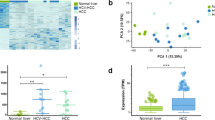Abstract
Background
The long noncoding RNA HOTAIR has been reported as a poor prognostic biomarker in patients with breast cancer. The aim of the present study is to examine the expression pattern of HOTAIR in hepatocellular carcinoma (HCC) and its clinical significance as well as its biological role in tumor progression.
Materials and Methods
We examined the expression of HOTAIR in 110 HCC samples using real-time reverse transcription-polymerase chain reaction and analyzed its correlation with clinical parameters and prognosis in 60 HCC patients that have undergone liver transplantation (LT). Suppression of HOTAIR using siRNA was performed to explore its roles in tumor progression.
Results
The expression level of HOTAIR in cancer tissues was higher than in adjacent noncancerous tissues. High expression level of HOTAIR was an independent prognostic factor for predicting HCC recurrence in LT patients (P = .001, hazard ratio, 3.564). Furthermore, in patients exceeding the Milan criteria, those with a high expression level of HOTAIR revealed a significantly shorter recurrence-free survival. Moreover, siRNA suppression of HOTAIR in a liver cancer cell line reduced cell viability and cell invasion, sensitized TNF-α induced apoptosis, and increased the chemotherapeutic sensitivity of cancer cells to cisplatin and doxorubicin.
Conclusions
The high expression level of HOTAIR in HCC could be a candidate biomarker for predicting tumor recurrence in HCC patients who have undergone liver transplant therapy and might be a potential therapeutic target.



Similar content being viewed by others
References
Parkin DM, Bray F, Ferlay J, Pisani P. Global cancer statistics, 2002. CA. Cancer J Clin. 2005;55:74–108.
El–Serag HB, Rudolph KL. Hepatocellular carcinoma: epidemiology and molecular carcinogenesis. Gastroenterology. 2007;132:2557–76.
Mazzaferro V, Regalia E, Doci R, Andreola S, Pulvirenti A, Bozzetti F, et al. Liver transplantation for the treatment of small hepatocellular carcinomas in patients with cirrhosis. N Engl J Med. 1996;334:693–9.
Zimmerman MA, Ghobrial RM, Tong MJ, Hiatt JR, Cameron AM, Hong J, et al. Recurrence of hepatocellular carcinoma following liver transplantation: a review of preoperative and postoperative prognostic indicators. Arch Surg. 2008;143:182–8.
Guttman M, Amit I, Garber M, French C, Lin MF, Feldser D, et al. Chromatin signature reveals over a thousand highly conserved large non-coding RNAs in mammals. Nature. 2009;458:223–7.
Mattick JS. The genetic signatures of noncoding RNAs. PLoS Genet. 2009;5:e1000459.
Bernstein E, Allis CD. RNA meets chromatin. Genes Dev. 2005;19:1635–55.
Dinger ME, Amaral PP, Mercer TR, Pang KC, Bruce SJ, Gardiner BB, et al. Long noncoding RNAs in mouse embryonic stem cell pluripotency and differentiation.Genome Res. 2008;18:1433–45.
Rinn JL, Kertesz M, Wang JK, Squazzo SL, Xu X, Brugmann SA, et al. Functional demarcation of active and silent chromatin domains in human HOX loci by noncoding RNAs. Cell. 2007;129:1311–23.
Gupta RA, Shah N, Wang KC, Kim J, Horlings HM, Wong DJ, et al. Long non-coding RNA HOTAIR reprograms chromatin state to promote cancer metastasis. Nature. 2010;464:1071–6.
Wu LM, Zhang F, Xie HY, Xu X, Chen QX, Yin SY, et al. MMP2 promoter polymorphism (C-1306T) and risk of recurrence in patients with hepatocellular carcinoma after transplantation. Clin Genet. 2008;73:273–8.
Mazzaferro V, Llovet JM, Miceli R, Bhoori S, Schiavo M, Mariani L, et al. Predicting survival after liver transplantation in patients with hepatocellular carcinoma beyond the Milan criteria: a retrospective, exploratory analysis. Lancet Oncol. 2009;10:35–43.
Befeler AS, Hayashi PH, Di Bisceglie AM. Liver transplantation for hepatocellular carcinoma. Gastroenterology. 2005;128:1752–64.
Yao FY, Ferrell L, Bass NM, Bacchetti P, Ascher NL, Roberts JP. Liver transplantation for hepatocellular carcinoma: expansion of the tumor size limits does not adversely impact survival. Hepatology. 2001;33:1394–403.
Zheng SS, Xu X, Wu J, Chen J, Wang WL, Zhang M, et al. Liver transplantation for hepatocellular carcinoma: Hangzhou experiences. Transplantation. 2008;85:1726–32.
Nguyen DX, Massagué J. Genetic determinants of cancer metastasis. Nat Rev Genet. 2007;8:341–52.
Chiang AC, Massagué J. Molecular basis of metastasis. N Engl J Med. 2008;359:2814–23.
Khalil AM, Guttman M, Huarte M, Garber M, Raj A, Rivea Morales D, et al. Many human large intergenic noncoding RNAs associate with chromatin-modifying complexes and affect gene expression. Proc Natl Acad Sci U S A. 2009;106:11667–72.
Ponting CP, Oliver PL, Reik W. Evolution and functions of long noncoding RNAs. Cell. 2009;136:629–41.
Schwartz M, Dvorchik I, Roayaie S, Fiel MI, Finkelstein S, Marsh JW, et al. Liver transplantation for hepatocellular carcinoma: extension of indications based on molecular markers. J Hepatol. 2008;49:581–8.
Schmidt C, Marsh JW. Molecular signature for HCC: role in predicting outcomes after liver transplant and selection for potential adjuvant treatment. Curr Opin Organ Transplant. 2010;15:277–82.
Acknowledgment
This study was supported by the Major National S&T Program (2008ZX10002-026) and National Key Technology Support Program (2008BAI60B03). We thank the surgeons and nurses who kindly facilitate the recruitment and collection of patient information.
Author information
Authors and Affiliations
Corresponding author
Additional information
Z. Yang, L. Zhou, and L.-M. Wu contributed equally to this work.
Electronic supplementary material
Below is the link to the electronic supplementary material.
10434_2011_1581_MOESM1_ESM.eps
Supplementary material 1 (A) Kaplan-Meier curves estimate the recurrence-free survival rates according to the expression of HOTAIR combined with Milan criteria in 60 HCC patients who underwent LT. (B) Kaplan-Meier curves estimates the recurrence-free survival rates according to the expression of HOTAIR in 24 HCC patients who underwent hepatic resection (EPS 829 kb)
Rights and permissions
About this article
Cite this article
Yang, Z., Zhou, L., Wu, LM. et al. Overexpression of Long Non-coding RNA HOTAIR Predicts Tumor Recurrence in Hepatocellular Carcinoma Patients Following Liver Transplantation. Ann Surg Oncol 18, 1243–1250 (2011). https://doi.org/10.1245/s10434-011-1581-y
Received:
Published:
Issue Date:
DOI: https://doi.org/10.1245/s10434-011-1581-y




